SAP S/4HANA Conversion or SAP S/4HANA New Implementation?
Abstract
Many IT heads are currently in a quandary about the choice between converting their existing SAP ECC system to S/4HANA, or starting from scratch and doing a Greenfield SAP S/4 HANA Implementation. The choice is not always simple and indeed depends on many factors. Both options have their merits, demerits and difficulties. “Choosing the best” requires a scientific approach suggested by SAP and needs to consider the suggestions of experienced SAP S/4HANA Conversion experts.

My view is that the best choice is the one that incurs minimum deployment costs, minimum complexity, minimum disruption of users’ time, minimum downtime, retention of existing desirable functionality and minimum working hours to be able to execute the business processes on digital core and on the digital value network.
It is useful to bear in mind that if your SAP ECC system is not fit for one-step conversion (because of its technical and functional aspects), or your system is not at the minimum release level specified for one-step conversion, or out of maintenance system, or a non-Unicode system, or Dual-stack system: conversion activity may cost almost as much as a Greenfield implementation, and during conversion, there’s a distinct possibility that an unexpected situation may crop up, pushing costs up further.
In general, with either conversion or new implementation, there’s a good chance you’ll spend somewhat more than you have planned, but you don’t want to dig yourself into a big financial hole in either case. Make your decision based on the information you receive from experienced conversion consultants, follow the scientific approach provided by SAP and follow the tools and techniques provided by SAP for understanding System readiness for Conversion.
An experienced SAP S/4HANA Solution Architect or SAP S/4HANA Conversion Expert could envision Conversion possibilities you may not see and help you get maximum functionalities from your current system.
In this article, I will share my experiences of SAP S/4HANA implementation and SAP S/4 HANA Conversion/Upgrade projects that may be helpful for taking decisions over Greenfield implementation or Brownfield Implementation.
Your journey to SAP S/4 HANA
To digitalize, to get quick reporting, to remove complexity, to have a complete integrated business solution, to have functional completeness and to run simple!
Although SAP’s enterprise resource planning (ERP) ECC 6.00 integrates almost all the major processes of the business, sometimes customers discover that some essential functionalities are lacking. To address this and to complement their capabilities, both SAP and its customers have recognized the importance of collaboration. The enhanced capabilities of the new SAP S/4HANA addresses this.
SAP S/4HANA provides decision-makers with instant insight, common view of financial and operational data, provides flexible and easily consumable reporting, and automates business processes. The new SAP S/4HANA Finance solution is a comprehensive accounting solution and covers planning, analysis, accounting and financial-close powered by SAP HANA. Users can access all data in real time with the agility of traditional ERP processes and the system can react to “outside interference” by itself. The new solution is available both as a cloud and an on-premise edition thus allowing quick innovation cycles in the cloud.
Many SAP ECC customers are aiming for digital transformation to re-imagine their business model, business processes & customer experience. As the economy is undergoing digital transformation at breakneck speed, some business models may not work in the future, business networks may disintegrate, industry boundaries may evaporate, new players may emerge and shake the status quo, many of our products may get smart and our competitors may even get smarter than us. The world is changing: people, companies, industry… a new reality is evolving across the globe. One of the best options available to address this is SAP S/4HANA.

So, SAP ECC customers have been evaluating the situation to decide if it is SAP S/4HANA conversion or SAP S/4HANA re-implementation that is the best option for them. The decision will prove difficult if customers don’t follow the scientific approach provided by SAP. SAP has given some general guidelines and tools to help you to take such decisions. I will be highlighting the tools and techniques provided by SAP and adding my conversion and upgrade experience. These tools may help in revealing which option is right for you.
During my visits to clients, the common question has been about “cost” of conversion and cost of re-implementation. Many compare prices for both; the cost we pay for of conversion and cost we pay for re-implementation. Re-implementation is usually much more expensive than conversion, but the decision to do one versus the other should not be based on costs alone. There are many other things to consider…
What to consider & how do I get there?
Out of the three possible options in the SAP S/4HANA Transition path, this article is focused on two options: SAP S/4HANA New Implementation and SAP ECC to SAP S/4HANA Conversion. The third option SAP Landscape Transformation for S/4HANA is ideal for large enterprises with many instances of SAP and non-SAP ERP systems and customers who want to Consolidate into one global SAP S/4HANA system or perform selective data migrations. You can read more about SAP Landscape Transformation for S/4HANA here, below we focus on the first two options:
Option 1: Greenfield SAP S/4HANA Implementation (New Implementation)
The first option for SAP ECC customers and NON-SAP customers, is starting afresh with a new implementation either with SAP S/4HANA on-premise or with a “Cloud First” strategy. If you opt for a cloud solution, simply subscribe to SAP S/4HANA, then move data from legacy applications using migration tools.
Option 2: SAP S/4HANA Conversion
The second option is a system conversion. Your existing SAP solution, SAP ECC 6.00 running on a non-HANA database, or on HANA will be converted to SAP S/4HANA. If you are a customer already running ECC 6 on SAP HANA, you need to do a HANA technical upgrade from HANA 1.0 to HANA 2.0, then your SAP S/4HANA Conversion project.
Many SAP ECC customers are wondering how to make their move and asking questions about the convertibility of their present ECC System.
An SAP S/4HANA Conversion project is complex, and depends on several parameters of the existing SAP ECC system. Complexities may be IT-related, or business-related. In my previous projects, I have used different tools and techniques to identify the complexity and convertibility of SAP ECC Systems. I share my insights below:
Tool 1: Detailed Study of Client’s Business Processes and complexity of the present system. Then preparation of a Business Case either for Conversion and for re-implementation:
To build a business case, a SAP S/4HANA Solution Architect will first understand your current business processes; what are the modules you are using? What is the custom code you have? How complex is your custom code? How far does the present SAP ECC system support your current business processes? How is it working? What are the reports you have at present and what are the reports you are looking for in the future? What improvements are you looking for? What changes and additional functionalities do you want to activate? What are the future development plans or expansion plans for your organisation? What are the other applications you want to have in SAP either on-premise or on cloud? Unifying the functionality in the digital core, what is your SAP System release? How much data do you have to migrate? Is your system a Unicode or Non-Unicode system? Is your system an “AS ABAP” or Dual stack system?
The above and more questions will have to be analyzed to ascertain if SAP S/4HANA Conversion in one step is possible or if it needs a multi-step conversion approach, and whether SAP S/4HANA Conversion is beneficial or re-implementation would be better suited to your organization.
S/4HANA Solution Architects also need to understand what the clients’ actual goals are in switching to SAP S/4HANA and whether they can achieve these goals in a system conversion, or if they can only be achieved through re-implementation. They then prepare a business case for conversion and re-implementation, drafting a business case that specifies potential benefits and estimated costs for both conversion and re-implementation approaches.

If, after completing a technical feasibility analysis, an SAP S/4HANA specialist decides that conversion would be the best choice, they will continue a technical feasibility analysis and system readiness assessment to discover whether the ECC system is technically and functionally ready for system conversion from ECC 6.00 to SAP S/4HANA. For this, they use different tools and techniques, described below…
Business Case: System Conversion: SAP ERP ECC to SAP S/4 HANA
Not all SAP ECC systems may be flexible enough for conversion, or to readily adapt to all of the innovations available in SAP S/4HANA. SAP ECC customers must conduct an “SAP S/4HANA Readiness Assessment” to identify whether their system is ready for conversion and adoption of the new innovations. For this, they need to engage a highly experienced SAP S/4HANA Conversion specialist.
SAP Readiness Check for SAP S/4HANA 1709- FPS2
Based on the below points, an SAP Conversion Professional will finalize the assessment of your SAP ECC system’s convertibility:-
Tool 2 : Technical Requirements Study:
Business Case 1: If your SAP ERP version is lower than ECC 6.00: If your SAP ECC system is on a lower product version than ECC. 6 you first must first upgrade that to one of the supported product versions mentioned. You should handle the upgrade project to ECC 6. 00 separately. Once your system is upgraded to ECC 6 with any EHP, your system will meet one of the readiness assessment requirements.
Business Case 2: If your SAP ERP is on ECC 6.0 with 0 to 8 SAP Enhancement Package: Please be aware that your SAP ECC 6.00 system with any EHP, is potentially suitable for conversion.
Business Case 3: Out of Maintenance SAP ECC Systems: You should bring your systems up to SAP Maintenance level. Alternatively, I recommend a Greenfield Implementation for this type of customer. If your ECC system is out of maintenance, SAP will not support conversion activity. So, you will land in to further problems.
Business Case 4: Non-Unicode & Dual-stack systems:
It is a prerequisite that your system must be a Unicode system for the conversion. If it isn’t, then first perform Unicode conversion with one of the supported start releases as target, then perform the conversion to SAP S/4HANA. It is better not to include the Unicode conversion project in an SAP S/4HANA Conversion project; It must be taken up as a separate project and your SAP ECC system must be an AS ABAP system. Dual-stack systems are not supported for the conversion. Please refer to SAP Note 1686144 & SAP Note 1655335 for more information.

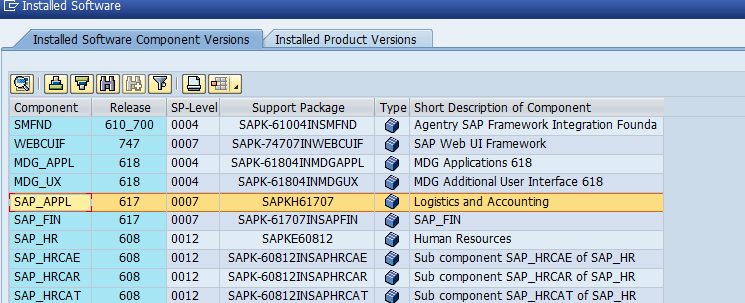
As per the checks above, we have Unicode support and a supported start release. Tool 2 has therefore given a favourable result for system conversion. We will then move on to tool 3.
Tool 3: Maintenance Planner
Maintenance Planner is used as a tool for SAP S/4HANA Conversion or SAP S/4HANA upgrades (from the lower versions of SAP S/4HANA to higher versions of SAP S/4 HANA).
It is essential that Solution Manager is properly installed. Maintenance Planner is required to generate an xml file. The Software Update Manager (SUM) uses this stack xml file for SAP S/4HANA conversion during the SUM phase.
The Maintenance Planner tool is used to verify whether add-ons on your system, business functions in your system and industry solutions used in your system, support system conversion or not. If there is no valid conversion path for any of the add-ons, IS or business functions, conversion to SAP S/4HANA is not possible as it prevents the conversion. So, this tool decides if conversion is possible for your system or not.
Maintenance Planner is a solution hosted by SAP. You can use your client’s S-User Id to utilise this tool. Maintenance Planner is the successor to Maintenance Optimizer and simplifies the maintenance process by consolidating critical tasks. See the screenshot below:
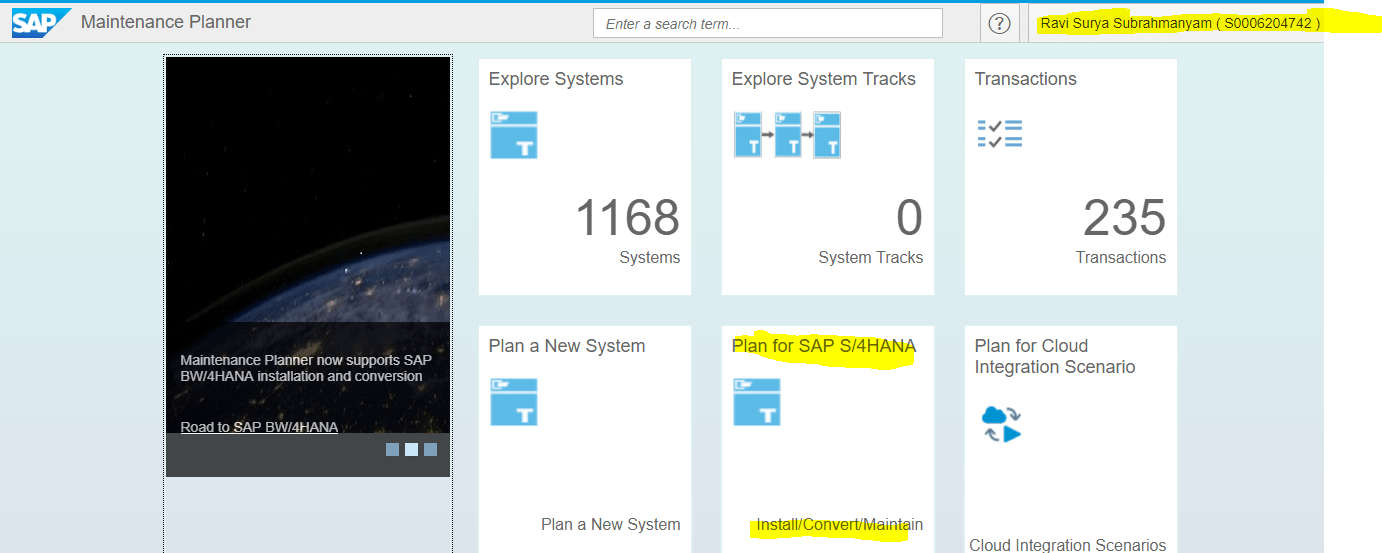
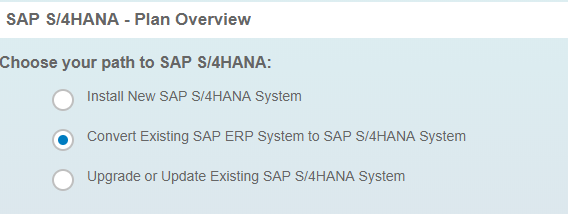
Select the system to be maintained, verify the system & Plan.
Result of the tool:
• Checks your add-ons
• Checks business functions to ensure compatibility with SAP S/4HANA
• Creates the stack file used for the actual conversion process.
• Checks if there are business functions in the technical system which are not supported
• Checks if note 2186164 is deployed on the SAP Solution Manager. If not applied, conversion planning is stopped
If the result of this tool specifies that no valid conversion path is found, as per present system status, the conversion is not possible. Consultants will need to do the required analysis to identify the reason(s), implement any necessary technical changes and re-execute.
Note: To generate the stack.xml, you need to have an SAP S/4HANA license. Without a license, you can do the above checks, but you cannot create a stack. During POC, you can execute Maintenance Planner without a license just to check if the system is convertible or not.
Tool 4: Simplification Item-Check:
This is a new tool provided by SAP S/4HANA 1709. The tool name is The “Simplification Item-Check Report”. It identifies simplification items relevant for your system. They will then be called by the Software Update Manager tool to ensure that the system is in a consistent state for S/4HANA Conversion.
Before you convert your SAP ERP system to SAP S/4HANA, an SAP S/4 HANA conversion specialist will analyze the impact on your system based on simplification items. To conduct a simplification item check in your SAP ECC System, follow the SAP Notes 2290622 or 2310438 to perform the check and implement the attached correction instruction SAP Note 2399707 in your ERP system.
If you would like to run the simplification item check including the consistency check for target the SAP S/4HANA version 1709, implement both SAP Note 2399707 and SAP Note 2502552.
As of now, the latest version is SAP S/4HANA 1709 Feature Package 2. Therefore, please consider SAP Notes 2399707 with version 98 and 2502552 with version 44 (the version may vary when you are doing the project) . Please see the screenshot below:
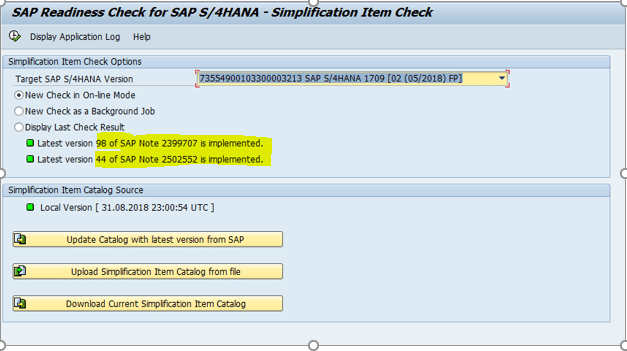
Note: SAP recommends using the production system to do the Simplification item check, otherwise, the results might not be accurate. If you are using a copy of the production system, implement and follow SAP Note 2568736 to prepare the necessary ST03N data.
Execution of the Simplification item check report: Use Transaction Code: SE38

Result of the report shown as below:
There are two types of check integrated into the program:
1. Relevance check: tells you whether an item is relevant to the system or not. The relevance is based on the simplification item catalogue.
2. Consistency check: which checks if the system is in a consistent state to ensure that the conversion can happen for the components shown. Only the items which are relevant to the system will be included in a consistency check. All remaining inconsistencies need to be solved before SUM enters downtime.
The consistency check warns about critical changes during conversion. To continue, you must confirm that you have understood the warning.
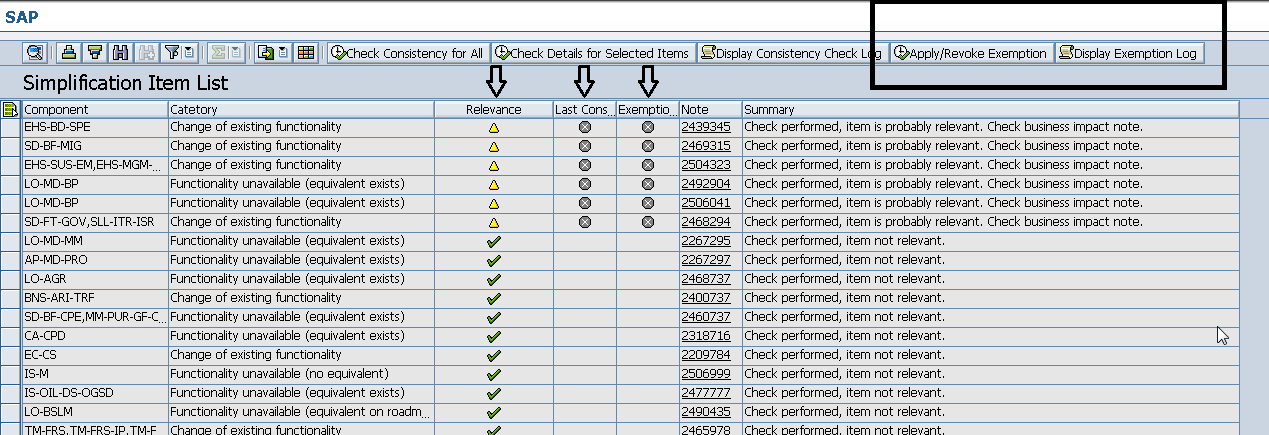
The consistency check is performed by individual check classes provided by each application area.
The warning / error message reported in the above screenshot is resolved. After resolving, execute the same report through SE38. Please see the screenshot below:
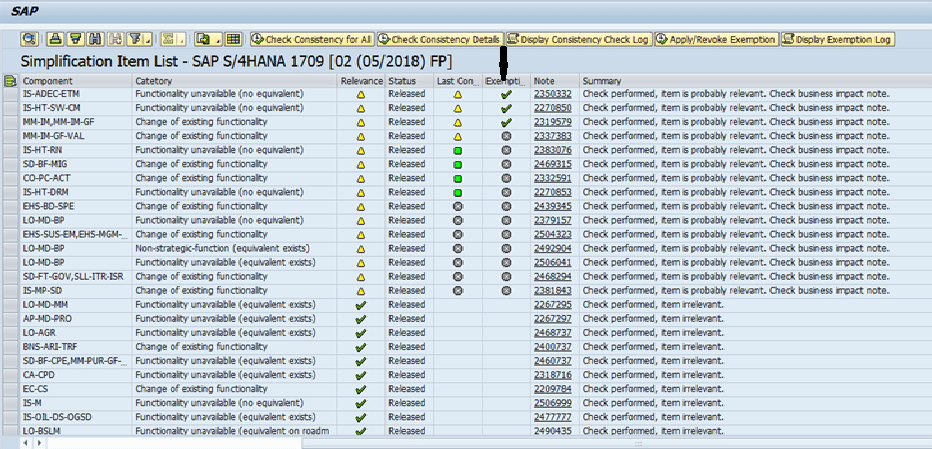
Implement the SAP notes specified to get rid of errors or warning messages. Then execute the simplification item check report /SDF/RC_START_CHECK again and repeat as necessary to resolve any errors found by the included consistency check; this is mandatory for any conversion. Consultants cannot ignore warning messages or error messages specified in this report.
Note: The overall check result return code must be lower than, or equal to four. If not, the Software Update Manager (SUM) will not be able to perform the conversion of your system. In case of errors, follow the instructions in the messages in the SAP Notes. Resolve all issues until the check report results in a return code under, or equal to, four.
A return code equal to four issues, if not mitigated, can cause data loss although it may not block conversion
An example of a return code of 4 can be seen in the screenshot below:

The example below shows a return code greater than 4, meaning it cannot be ignored.

Tool 5 : SAP Readiness Check for SAP S/4HANA:
When you are planning to convert an SAP ECC system to SAP S/4HANA, SAP Conversion experts recommend you use SAP Readiness Check for SAP S/4HANA.
You can execute this using two options to perform the SAP Readiness Check for SAP S/4HANA:
1. Using SAP Solution Manager
2. Without Solution Manager following SAP note 2310438
SAP recommends using the production system or a copy from a production system here, otherwise, the SAP Readiness Check results might not be accurate. Please follow SAP Note 2290622 for the SAP Readiness Check for SAP S/4HANA.
By executing the SAP Readiness Check you can better understand the implications of a conversion from an existing SAP ECC system to SAP S/4HANA. This Readiness check helps you to identify necessary preparations and pre-projects in the current system landscape, well before an SAP S/4HANA system conversion project starts.
The SAP Readiness Check for SAP S/4HANA shows system-specific information on adjustments that are mandatory for the conversion to SAP S/HANA
• Add-on compatibility
• Active business functions
• SAP S/4HANA simplification items
• Custom code
In addition, the SAP Readiness Check for SAP S/4HANA provides system-specific information regarding:
• SAP Custom Development projects
• SAP HANA sizing
• Analytics
• Adjustments that are needed for BW Extractors
Sample Readiness Assessment Check – results:

See the screenshot below for more details of the readiness of your SAP ECC System:
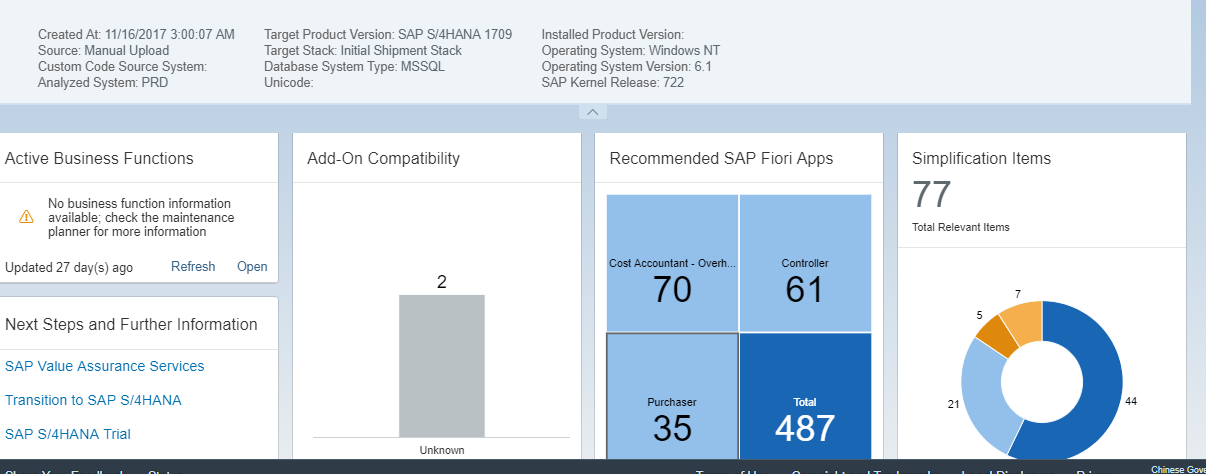
Interpretation of above Readiness Check result:
Number of Add-Ons : 2
No business function information available; check the maintenance planner for more information.
Simplification Checks are conducted by the Readiness Program, see the results below. Compare the above picture with the table below. The number of simplification items relevant for you is 77. See the count below. For relevant simplification items, please refer to relevant SAP notes specified in the Readiness Assessment report.
| Status | Number of Objects |
| Overall number of Simplification Items | 505 |
| Check performed, item is not relevant. No follow-up activity necessary. | 431 |
| Check performed, item is relevant (excludes “non strategic items”). Check business impact note. | 44 |
| Relevance cannot be automatically determined. (excludes “non strategic items”). Check business impact note. | 21 |
| Check performed, “non-strategic” item is relevant. Check business impact note. | 5 |
| Relevance for “non-strategic” item cannot be automatically determined. Check business impact note. | 7 |
Custom Code Adjustments for SAP S/4 HANA
Required Custom Code Adjustments for SAP S/4HANA Conversion will be shown by the readiness assessment: You can also do custom code analysis using a separate tool: SCI (ABAP Test Cockpit is the successor of Custom Code Inspector).
In general, the following changes may be required in a system conversion project to SAP S/4HANA:
• Adjusting the custom code to the simplified data model and simplification list in S/4HANA
• Re-applying modification using SPDD, SPAU
• Mandatory changes for SAP HANA
• Optimising performance of custom code
When you execute the SAP Readiness Check for SAP S/4HANA, the focus is on identifying areas of mandatory change (which are required due to the simplified application architecture of SAP S/4HANA).
You can also get a detailed Readiness Assessment report by clicking “Create Results Document” shown in the screenshot below:

Conclusion & Recommendations:
Does your SAP ECC system have what you consider to be a serious problem? It could be Reporting, Configuration of the Costing Module, or Chart of Accounts, or some other factor you can’t tolerate, a not-so-great system that will never meet the needs of your growing business? Or does it have Technical and Functional limitations that prevent it adopting innovations quickly (perhaps out of maintenance or heavily customized)? Many IT heads base their decision to go for re-implementation on the need for better reporting, better design of charts of accounts, better design of cost centre or profit centre hierarchies etc. However, a smarter conversion plan and an experienced conversion professional may also help you avoid re-implementation stress. Experienced consultants may be able to help with reconfiguration that may allow you to have an efficient system without needing to leave the present system. I would recommend consulting an experienced solution architect to lay out your conversion plan and see if a reconfiguration could make sense. It is often much less disruptive and expensive than a complete re-implementation and may solve your complex problems.
Create more usable space by simply clearing out the junk configuration, unused customisation, unused reports, and programmes to get your system more organised (Use tools like DVM or UPL). Good SAP Housekeeping can free up a lot of space. Knowingly or unknowingly, you might have activated some functionalities that may be holding back your system’s performance and unnecessarily increasing the complexity of your system.

Hiring a professional Conversion Consultant can be one of the most cost-effective ways to gain much-needed information to support the decision about whether to Convert or to re-implement. The truth is that re-implementation may not always be more expensive & Conversion may not always be more complex!
Sometimes, both Conversion and Re-implementation may be viable options. Consult with a professional SAP S/4HANA Solution Architect before making your final decision. Benefit from their experience and knowledge, rather than having to learn the hard way! – Eursap – Europe’s specialist recruitment agency can put you in touch with some of the best SAP S/4HANA experts on the market – please get in touch with Eursap today, to see how Eursap can assist you with your SAP S/4HANA resource requirements.
Author: Dr. Ravi Surya Subrahmanyam, PhD (Finance) – SAP S/4HANA Conversion/upgrade Expert & SAP Certified S/4 HANA Solution Architect – SAP Certified Application Professional – Financials in SAP S/4HANA 1709
Disclaimer: I cannot give any guarantee about the usage of the tools specified in the article. I have shared my personal experience and opinions with the intention of helping the SAP Consulting community.
Need to hire SAP S/4HANA resources?
Get in touch with Eursap – Europe’s Specialist SAP Recruitment Agency
